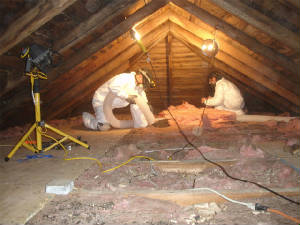Health risks from bats are often exaggerated. Nevertheless, large populations of roosting
bts may present the risk of disease to people nearby. The most serious health risks arise from disease organisms that can
grow in the nutrient-rich accumulations of bat droppings and debris under a roost — particularly if roosts have been
active for years. External parasites also may become a problem when infested bats leave roosts or nests. The parasites then
can invade buildings and bite people.

Histoplasmosis
Histoplasmosis is caused by a fungus
(Histoplasma capsulatum) found primarily in the areas drained by the Mississippi and Ohio rivers. Both humans and animals
can be affected. The disease is transmitted to humans by airborne fungus spores from soil contaminated by pigeon and starling
droppings (as well as from the droppings of bats). The soil under a roost usually has to have been enriched by droppings for
two years or more for the disease organism to reach significant levels. Although almost always associated with soil, the fungus
has been found in droppings (particularly from bats) alone, such as in an attic. Infection occurs when spores, carried by
the air are inhaled — especially after a roost has been disturbed. Most infections are mild and produce either no symptoms
or a minor influenza- like illness. On occasion, the disease can cause high fever, blood abnormalities, pneumonia and even
death. In some areas, including portions of Illinois, up to 80 percent of the population show evidence of previous infection.
Outbreaks of histoplasmosis have occurred in Central Illinois. The National Institutes of Health (NIH) has reported a potentially
blinding eye condition — presumed ocular histoplasmosis syndrome (OHS) — that probably results from the fungus.
NIH estimates that 4 percent of those exposed to the disease are at risk of developing OHS.
Bats and Disease
Bats are associated with a few diseases that
affect people, such as rabies and histoplasmosis. Rabies is a dangerous, fatal disease, but only about 5 percent of bats submitted
for testing are infected with the rabies virus. In recent years, there has been increased concern about the risk of rabies
transmission following contact with bats. If an injured or ill bat is found in or around a structure, it should be removed.
Because most bats will try to bite when handled, they should be picked up with tongs or a shovel. (please contact us or your
local animal control officer) If a bat has bitten or scratched a person or pet or is found in your home, capture the bat without
touching it with your hands (use gloves) and without crushing its head. If the bat is dead, refrigerate it (DO NOT freeze)
and then contact your local health department immediately for instructions. Bats with rabies have been identified in
most areas of the state. In recent years, bats have been the most common animal identified with rabies in the state. The incidence
of histoplasmosis being transmitted from bat droppings to humans is not thought to be high. Nevertheless, fresh bat droppings
(unlike fresh bird dropping) can contain the histoplasmosis fungus. Bat droppings do not need to come into contact with soil
to be a source of the disease.

Removal and cleanup of bird and bat droppings
If there
is a SMALL accumulation of droppings from a few birds or bats, it can be cleaned up with soap and water.
BUT, IF
AREA is large such as in an attic a professional, such as ourselves, should be contacted for proper removal of the guano,
santization, and area restoration. Also, outside exclusion of your residence for re-entry.
|

